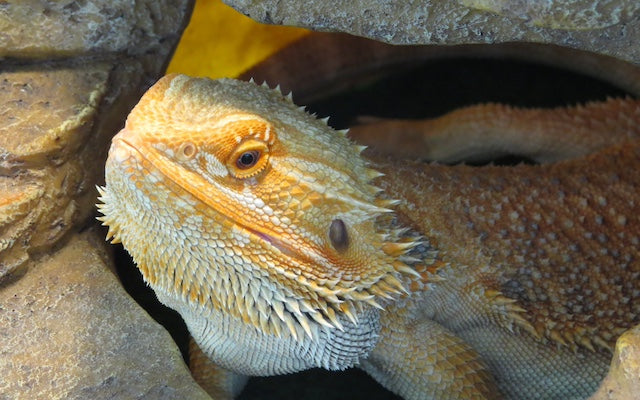If you’ve got a bearded dragon, you’ve probably heard of gut impaction. Gut impaction is a common but serious issue that can cause death in severe cases. Here’s everything you need to know about gut impaction, including how to prevent it and what to do if your bearded dragon becomes impacted.
What Is Gut Impaction in Bearded Dragons?
Gut impaction is when undigested or indigestible matter gets stuck in the bearded dragon’s digestive tract and is unable to pass through while at the same time blocking anything else from passing through.
Impaction can cause serious health issues or death, but in many cases it is preventable.
Is Constipation the Same as Impaction in a Bearded Dragon?
There is some confusion over whether constipation and impaction are the same thing, and whether one is more serious than the other. The BioDude explains:
“Constipation, as you probably already know, is a condition in which an animal has difficulty with passing stool or passes stool infrequently. Impaction occurs when constipation is caused by a blockage in the digestive tract.”
So impaction is a type of constipation—and a more serious form of it, at that.
Symptoms of Bearded Dragon Impaction
Some bearded dragon impaction symptoms are mild, and some are intense. The milder symptoms may indicate constipation, rather than impaction.
Mild symptoms:
- Appetite loss
- No bowel movements
- Fatigue / lethargy
Severe symptoms:
- Paralysis or partial paralysis (e.g. difficulty moving one or both rear legs, or inability to move them at all)*
- Trembling limbs
- Visible lump along the abdomen or back
*This will occur if the mass in the intestines pushes into the spine. Bearded dragon spines have no discs, leaving vertebrae vulnerable to pressure.
Two of these symptoms—paralysis/partial paralysis and trembling limbs—can also indicate metabolic bone disease. Any time your dragon is struggling to get around as usual, it’s time to call the vet.

What Causes Impaction in Bearded Dragons?
Bearded dragon impaction can be caused by a variety of factors, including:
- Accidentally ingesting an inedible substance or item, such as a piece of a low-quality plastic plant or a large piece of loose substrate (such as pebbles or walnut shells)
- Eating food or bugs that are too big
- Eating too many insects that have a hard exoskeleton
- Having inadequate heat and/or UVB exposure
- Eating a nutritionally deficient diet
- Overeating and/or obesity
- Not getting exercise or enough activity during the day
Treatment for Bearded Dragon Impaction: What to Do & What to Expect
For a mild case of impaction, there are two things you can try at home before the vet appointment:
- Encourage your dragon to drink some water.
- Give your dragon a 30-minute warm bath with a gentle abdominal massage.
If this doesn’t work (or if the impaction is severe), call your vet. Here’s what you can expect at the appointment:
- Your vet will likely x-ray your dragon to determine the location, size, and severity of the impaction.
- Based on the findings of the x-ray, your vet may perform a massage, prescribe laxatives, or recommend surgery.
- A catheter or syringe may be inserted into the cloaca to flush out the impacted object.
- Antibiotics might be prescribed after the procedure.
Pro Tip: If your dragon is impacted, don’t place him on his back. This can further damage the spinal cord and cause difficulty breathing.
How to Prevent Bearded Dragon Impaction
Like most health issues, when it comes to impaction, prevention is easier than treatment. Here are some key ways to protect your bearded dragon from the risk of impaction.
Don’t use cheap decor. When you’re decorating the terrarium, use high-quality decor that won’t break easily. Avoid flimsy plants and logs. Make sure there is nothing your dragon could scratch or bite off of the basking rock, hammock, or any hideaway spots.
Avoid (most) loose substrates. Loose substrates are often dangerous for bearded dragons. Although some loose substrates are safer than others, the following are very hazardous:
- Sand
- Pebbles and rocks
- Walnut shells
- Anything “edible” such as Calci-sand
Tile, excavator clay, reptile carpet, and even newspaper tend to be better options than loose substrate.
Check the size of the food. Always make sure your bearded dragon’s food—especially feeder insects—are no bigger than the space between your bearded dragon’s eyes.
Encourage regular exercise. Regular activity helps promote healthy digestion. Make sure your bearded dragon stays active—take him outside for walks, make sure his terrarium is big enough for him to run around, and make sure you include logs and rocks in the enclosure for him to climb.
Even with the best prevention and care, sometimes impaction does happen. The earlier you catch and treat it, the better chance your dragon has at a healthy recovery.
Sources & Additional Reading
(Please note the first two links contain dissection images, which some readers may want to avoid)
- https://reptifiles.com/bearded-dragon-care/bearded-dragon-illnesses-health/impaction/
- http://www.beardeddragonlady.com/impaction.html
- https://veterinarypartner.vin.com/default.aspx?pid=19239&catId=102919&id=7996830
If you have questions or would like to give feedback, please email us at team@dragonsdiet.com








